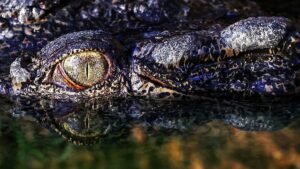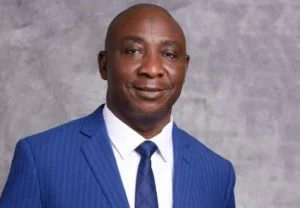Brisbane 2032: Olympic rowers may have to paddle with predators


By Olawale Lawanson Alabi
Abuja, August 22, 2025 (crestnewsonline.ng) The Olympic Games of Brisbane in 2032 could have a unique and bizarre scene: a river shared by top canoeists… and crocodiles.
The Fitzroy, the natural habitat of these prehistoric reptiles, has been proposed as the venue for the aquatic events, according to insidethegames.biz, an Olympic sports publication.
The doubt now is whether safety and spectacle can coexist, the online publication added.
Along the banks of the Fitzroy, known as Martuwarra to the Nyikina and Bunuba peoples, in the heart of Rockhampton, Queensland, crocodile murals and warning signs serve as monuments to a community whose identity is forged through a hard-worn rapport with a primordial apex predator.
Here, amid brown waters fed by more than 20 tributaries, across a basin stretching 93,829 square kilometres, and in the company of wading birds breaking the silence, a new debate is gathering pace: could this really be the stage for an Olympic regatta?
The prospect surfaced publicly in February, when Sarah Black, president of the Fitzroy Rowing Club, told a Senate hearing that her hometown could host Olympic and Paralympic rowing in Brisbane 2032.
“The Fitzroy is a natural crocodile habitat, we’re very aware of that,” she admitted, dismissing what she called “sensationalist commentary” hyperbolising the threat as if it were an infestation.
“We have established processes with environmental authorities. We monitor crocodile behaviour throughout the year. It’s a managed risk, and our sport knows how to deal with it,” she insisted.
Black is not alone.
Rowing Australia’s chief executive and former Olympian Sarah Cook has also backed Rockhampton’s case.
In March, the Queensland Government went further still, formally announcing that the Fitzroy would stage rowing and canoe sprint in seven years’ time.
In a recent feature for The Guardian, a British tabloid, journalist Joe Hinchliffe traced the riverbanks, spoke with clubs, athletes and residents, and offered a more layered perspective.
Andrew Miller, president of the local canoeing club, captured the fragility of the sport in stark terms, “It’s like sitting on a pencil,” he said, referring to the elite K1 boats.
“If a crocodile nudges you, you’re straight in the water.”
The risk is not imagined.
Warning signs dotted along the river caution of injury or death from saltwater crocodiles.
Government surveys estimate their density at around 0.2 per kilometre, not high, but far from negligible.
Management plans require rangers to remove “all large and dangerous crocodiles” along a 20-kilometre stretch upstream from the main weir.
At the Fitzroy Rowing Club, the reporter informs that, where a stuffed crocodile mascot named ‘Fitzy’ hangs from the rafters and leaflets titled Croc Wise are handed out, members emphasise decades of incident-free training.
The paddling community has rowed here since the late 1970s and insists no attacks have ever been recorded.
“We’re on the water nearly every day, even at night,” Miller told the British outlet.
During his stay, Hinchliffe witnessed tranquil dawns, seabirds breaking the surface, and a river as serene as it was compelling.
Nevertheless, he also reached stretches known locally as “croc territory”, where even the most seasoned paddlers remain on edge.
The University of Queensland hosts the world’s largest crocodile monitoring programmeMand its director, Professor Craig Franklin, voiced ‘concerns on multiple levels’ about Olympic plans for the Fitzroy.
While no recent incidents have been logged, he warned, the risk is not nil, and the visibility of the Games allows no room for error.
Public opinion reflects the same ambivalence.
In the story’s comment section, one reader, ‘Crawdaddy‘, quipped, “Who needs doping if a crocodile can boost your performance? A shark in the pool, big cats on the track, and a magpie for the cyclists! Brilliant.”
His sharp sarcasm reflects somewhat the usual tone of reader feedback, such as Rocketrocket, but the latter struck a more sober note based on his own experience.
“This controversy will certainly get Rockhampton into the international news in the lead up to the Olympics and during the Games. Having lived in far north tropical Australia all I can say is that no river or waterhole is ever 100 percent safe.”
The tension between the watercourse’s wild beauty and its reputation as crocodile country lies at the heart of the debate.
Unlike tidal rivers thick with mud, the freshwater reaches above the weir, are seen locally as ‘pristine,’ a natural rowing course.
Advocates argue the barrier between salt and fresh water, combined with existing wildlife management infrastructure, makes it suitable.
Yet the challenge is not only ecological.
Staging Olympic competition demands strict compliance with international safety standards, public confidence and robust logistics.
At an event of this magnitude, even an unlikely accident could spiral instantly into global scrutiny.
However, the Premier of Queensland David Crisafulli demonstrated his confidence in early July that the venue would host rowing events for the 2032 Olympic Games, despite ongoing debate about the suitability of the site’s waters.
Weeks later, he appeared before the media again and reaffirmed his position, “Rowing is practised in Rocky, and we are taking the necessary steps to build a first-class facility.”
“That’s what good governments do, and that’s our commitment to the people, not only in central Queensland, but across the country,” added the 46-year-old politician.
Adding expert weight to the head of state’s presence was Shaneel Chandra, the one-time scientific director of the Great Barrier Reef and World Heritage Office, a branch of the Department of Environment, Science and Innovation.
The professor did not hesitate to endorse the tests being carried out by the Independent Gaming Infrastructure and Coordination Authority (GIICA).
“I believe that with the right controls in place, the Fitzroy River will be able to meet international standards in general.”
Despite the fact that it seems like a fairly solid decision, whose harmony and acceptance has been adapted by almost all the actors involved in the organisation of the Games, there is already a “Plan B”.
Obviously, as with all large-scale events, as was the case with the dubious bobsleigh and skeleton track, forcing Lake Placid in New York to apply as an alternative on the other side of the Atlantic for Milano Cortina 2026.
Yet it will ultimately not be activated.
If the venue fails the test, the event could be moved south and return to Penrith, as in the Sydney 2000 Games.
While no plans have been made to change the location, several other regions are preparing their cases to host the key event, including the Scenic Rim and Somerset Regional Councils.
Local authorities and sporting bodies remain intent on pressing ahead, aware of the power of turning an overlooked pocket of central Queensland into a global stage.
Thus, the core conundrum persists: whether the mythos of adventure on a dynamic river can find alignment with the meticulously engineered, zero-tolerance safety standards of the Olympic Games.
For now, pelicans still glide across the Fitzroy’s brown waters, cockatoos shriek from the eucalyptus trees, and kayakers continue their training as though nothing disturbs the dawn.
But as 2032 approaches, that calm will be tested.
Can the Fitzroy, with all its raw beauty, carry the Olympic rings without awakening its ancient reptilian residents?
The answer, like the river itself, meanders downstream, unresolved, and still flowing.
And as Crisafulli says, “we have time and a plan to execute it,” which, although he hopes that the competitions will not leave the jurisdiction of his borders, the organisers’ leadership has already shown that they have alternatives in case Fitzroy’s bid falls through.
Fingers are in the mean time all crossed though.(www.crestnewsonline.ng)




